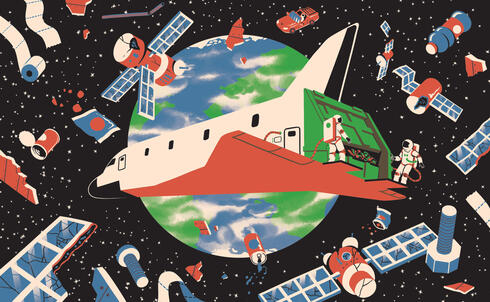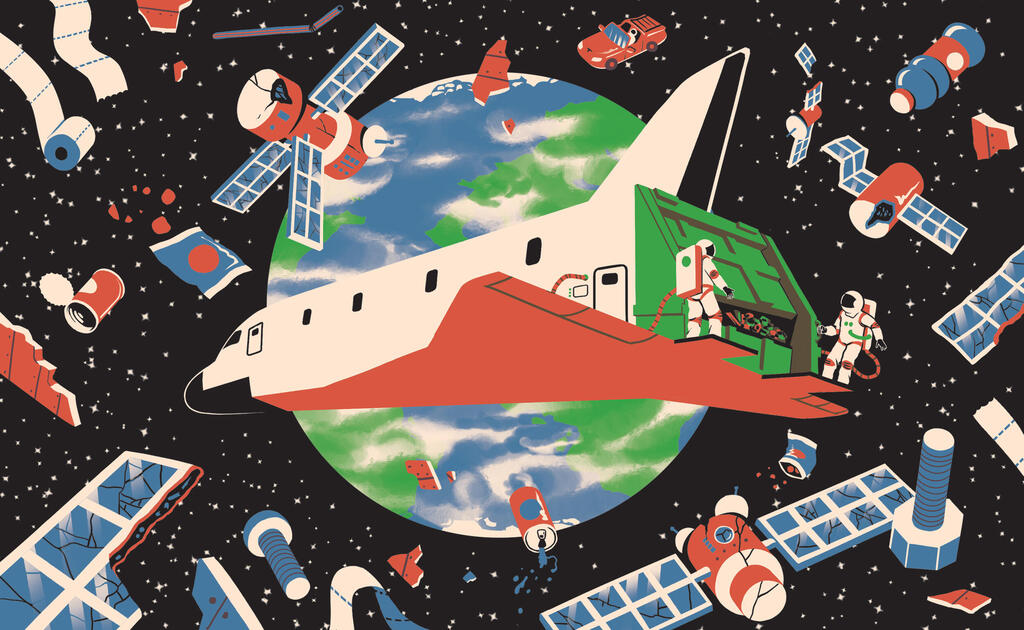
Waste in Space: Near space is getting more crowded, and more polluted
The amazing capacity of the human race to produce waste has not been limited to the borders of our planet. There are currently about 3,000 inactive satellites that are hovering around us along with hundreds of millions of pieces of waste. One day this will affect us land inhabitants as well
Humans fill the earth with waste. From the sea to the land and even in the rainwater and on the most isolated mountain peaks, plastic particles and waste residues have already been found. The landfills are overflowing with various types of leftovers of our lives, until countries are already struggling to find a place for the rising mountains of garbage. But the problem produced by humans does not stop on Earth - it is already crowding space, in a growing trend that causes concern among researchers and governments around the world.
The image of space as vast and empty no longer applies to our immediate environment: the environment close to the Earth is beginning to become more crammed. 66 years ago a single object cruised beyond Earth: Sputnik, the Soviet Union's first satellite, launched on October 4, 1957. But since the 1950s, thousands of man-made craft have been launched out of our blue planet. Most of the time they do not return to Earth, and become a problem far from sight. Abandoned technologies, remnants of spaceships, lost tools, rockets and satellites that did not work or died after their mission: space is getting filled with waste that humans have thrown into it, and is already overflowing with hundreds of tons of garbage that is becoming more dangerous every day.
Currently, there are about 9,000 active satellites outside the Earth, and this number may increase to more than 60,000 by 2030. Many of these satellites will be used to provide internet access to developing countries or to monitor agriculture and climate on Earth. Companies like SpaceX have dramatically lowered launch costs, which has fueled this wave of activity in recent years. Space debris is steadily increasing: during the last five years, its amount has increased by 50%, according to the European Space Agency.
How much junk have humans left in space? According to the European Space Agency, alongside the active satellites, there are also 3,000 "dead" satellites polluting space. As large objects collided with each other over the years, they broke up into debris particles that set off on their own new path. Now add to these large satellites about 34,000 particles of space junk with a size of more than 10 cm, which the research bodies manage to monitor and measure. NASA estimates that there are an additional 1 million objects with a size of 1-10 cm, 128 million objects with a size of between 1 mm and 1 cm and 100 million pieces of debris with a size of a millimeter.
Most of the waste, smaller than a centimeter in size, cannot be identified and measured but only evaluated. These tiny objects can be anything from flecks of paint from rockets, stray screws, or small fragments created by crashes. But when they fly at a speed of about 28,000 km/h in their orbit, they can still cause a serious problem if they hit the functioning satellites we sent into space.
"No one has an interest in solving the problem"
A large proportion of objects moving in lower orbits - a few hundred kilometers from Earth - can return to it quickly. Sometimes they re-enter the atmosphere after a few years and in most cases they burn up so they don't reach the ground. But this optimistic figure is joined by two big problems: we transport waste in a greater quantity than the speed of disintegration of those tiny objects and their burning in the atmosphere, and they are not the only ones either. Debris or satellites left at higher altitudes of 36,000 kilometers - where communications and weather satellites are often placed in circular orbits around the Earth - can continue to orbit the Earth for hundreds or even thousands of years. And as they float through space, which becomes more and more dense and crowded, they can collide with each other and break up into thousands of new pieces, thus creating thousands of new and dangerous pieces of debris.
"We leave a lot of garbage in space," says Prof. Pini Gurfil from the Space Research Institute at the Technion. "In 2007, the Chinese intercepted their satellite from Earth and this increased the total number of particles by 25%. Satellites that fly at low altitudes have to burn themselves up in the atmosphere after 25 years from the end of the mission. In practice, this is not really enforced, but this is the international regulation designed to reduce the damage. If you look at this problem honestly, this is the only option to prevent the problem. No one has a real interest in solving this problem through active solutions of launching dedicated satellites to collect space debris, because this would be a very expensive task. When you weigh the different considerations, you prefer to lose a satellite than to launch a complex and expensive satellite that will collect the waste."
"The next generation will feel the impact"
The race of commercial companies into space is going to exacerbate the problem even more, when regulation established on Earth is not really enforced outside of it. Gurfil explains: "The debris in space is going to grow exponentially. Elon Musk alone plans to launch tens of thousands of satellites and so does Jeff Bezos, with the aim of creating a global internet infrastructure. This is going to greatly complicate the problem of space debris. People who know this issue and have something on their minds other than dollar signs are horrified by this. They understand what would happen if there were to be a collision between two of these satellites. The more we launch, the more likely they will collide. There are malfunctions that are beyond the control of the human operator. It's hard to predict what's going to happen. Jeff Bezos and Elon Musk are avoiding this question. They have no answer and it is disturbing. This is even before we talked about the fact that the problem we created in space also makes it difficult to leave the borders of the earth today: there are certain altitudes today, about 800 km, to which satellites are not usually launched because of a load of debris. In fact, at this altitude the probability of collision with space debris can reach up to about 7%. This is a very high probability in space terms. In higher orbits, such as those used by launchers of communication satellites, there is almost no natural decay of the debris, so the problem is expected to significantly worsen, and in the future even completely prevent satellite launches to certain orbits."
On Earth, our waste causes severe damage to natural systems, animal death, greenhouse gas emissions and unprecedented pollution. What does the debris floating in space cause?
"There are hundreds of millions of small fragments that merge with micrometeorites in space and form a kind of disk around the Earth. We don't know what the consequences of this are, but we know that they have effects on the Earth's magnetic field that protects us from radiation and the amount of light that comes from the Sun. Indirectly , it may also affect the weather on Earth. There are preliminary indications that our pollution in space affects our life here. It is a whole microcosm that has factors that affect each other. These are effects that the next generation will feel even we don't."















